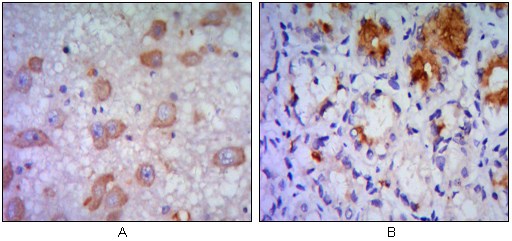IRE1α Monoclonal Antibody
- Catalog No.:YM0381
- Applications:WB;IHC;IF;ELISA
- Reactivity:Human
- Target:
- IRE1α
- Fields:
- >>Autophagy - animal;>>Protein processing in endoplasmic reticulum;>>Apoptosis;>>Non-alcoholic fatty liver disease;>>Alzheimer disease;>>Parkinson disease;>>Amyotrophic lateral sclerosis;>>Huntington disease;>>Spinocerebellar ataxia;>>Pathways of neurodegeneration - multiple diseases;>>Lipid and atherosclerosis
- Gene Name:
- ERN1
- Protein Name:
- Serine/threonine-protein kinase/endoribonuclease IRE1
- Human Gene Id:
- 2081
- Human Swiss Prot No:
- O75460
- Mouse Swiss Prot No:
- Q9EQY0
- Immunogen:
- Purified recombinant fragment of human IRE1α (aa282-433) expressed in E. Coli.
- Specificity:
- IRE1α Monoclonal Antibody detects endogenous levels of IRE1α protein.
- Formulation:
- Liquid in PBS containing 50% glycerol, 0.5% BSA and 0.02% sodium azide.
- Source:
- Monoclonal, Mouse
- Dilution:
- WB 1:500 - 1:2000. IHC 1:200 - 1:1000. ELISA: 1:10000.. IF 1:50-200
- Purification:
- Affinity purification
- Storage Stability:
- -15°C to -25°C/1 year(Do not lower than -25°C)
- Other Name:
- ERN1;IRE1;Serine/threonine-protein kinase/endoribonuclease IRE1;Endoplasmic reticulum-to-nucleus signaling 1;Inositol-requiring protein 1;hIRE1p;Ire1-alpha;IRE1a
- Molecular Weight(Da):
- 110kD
- References:
- 1. Biochem Biophys Res Commun. 2004 Apr 30;317(2):390-6.
2. Mol Cell Biol. 2005 Sep;25(17):7522-33.
3. Science. 2007 Nov 9;318(5852):944-9.
- Background:
- The protein encoded by this gene is the ER to nucleus signalling 1 protein, a human homologue of the yeast Ire1 gene product. This protein possesses intrinsic kinase activity and an endoribonuclease activity and it is important in altering gene expression as a response to endoplasmic reticulum-based stress signals. [provided by RefSeq, Jul 2008],
- Function:
- catalytic activity:ATP + a protein = ADP + a phosphoprotein.,cofactor:Magnesium.,enzyme regulation:The kinase domain is activated by trans-autophosphorylation. Kinase activity is required for activation of the endoribonuclease domain.,function:Senses unfolded proteins in the lumen of the endoplasmic reticulum via its N-terminal domain which leads to enzyme auto-activation. The active endoribonuclease domain splices XBP1 mRNA to generate a new C-terminus, converting it into a potent unfolded-protein response transcriptional activator and triggering growth arrest and apoptosis.,PTM:Autophosphorylated.,similarity:Belongs to the protein kinase superfamily. Ser/Thr protein kinase family.,similarity:Contains 1 KEN domain.,similarity:Contains 1 protein kinase domain.,subunit:Homodimer; disulfide-linked. Dimer formation is driven by hydrophobic interactions within the N-terminal luminal domains
- Subcellular Location:
- Endoplasmic reticulum membrane ; Single-pass type I membrane protein .
- Expression:
- Ubiquitously expressed. High levels observed in pancreatic tissue.
Activation of UPR Signaling Pathway is Associated With the Malignant Progression and Poor Prognosis in Prostate Cancer. PROSTATE 2016 Oct 08 IHC Human 1:100 Prostate cancer tissues
α-Hederin induces human colorectal cancer cells apoptosis through disturbing protein homeostasis. CHEMICO-BIOLOGICAL INTERACTIONS Haibo Cheng WB Human HCT116 cell
- June 19-2018
- WESTERN IMMUNOBLOTTING PROTOCOL
- June 19-2018
- IMMUNOHISTOCHEMISTRY-PARAFFIN PROTOCOL
- June 19-2018
- IMMUNOFLUORESCENCE PROTOCOL
- September 08-2020
- FLOW-CYTOMEYRT-PROTOCOL
- May 20-2022
- Cell-Based ELISA│解您多样本WB检测之困扰
- July 13-2018
- CELL-BASED-ELISA-PROTOCOL-FOR-ACETYL-PROTEIN
- July 13-2018
- CELL-BASED-ELISA-PROTOCOL-FOR-PHOSPHO-PROTEIN
- July 13-2018
- Antibody-FAQs
- Products Images

- Western Blot analysis using IRE1α Monoclonal Antibody against Raji (1), A431 (2), Jurkat (3), HeLa(4) and HEK293 (5) cell lysate.

- Immunohistochemistry analysis of paraffin-embedded human brain tissue (A) and stomach tissue (B), showing cytoplasmic localization with DAB staining using IRE1α Monoclonal Antibody.



